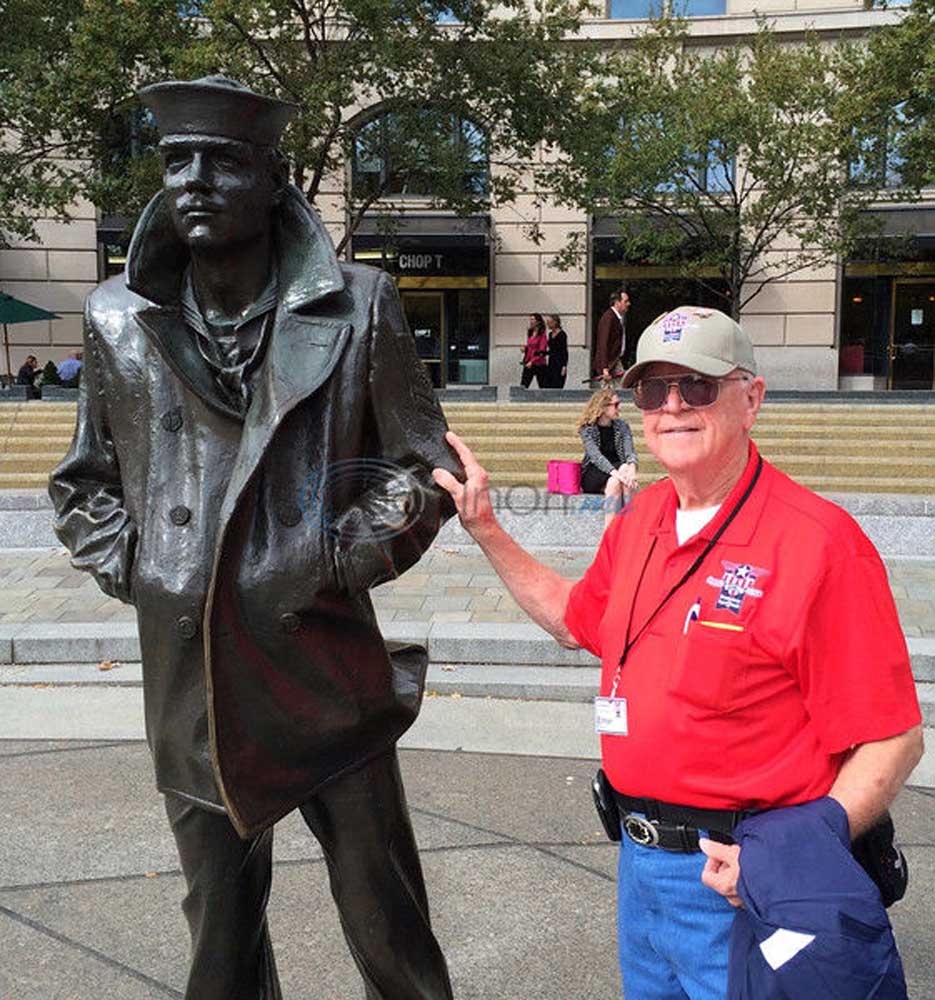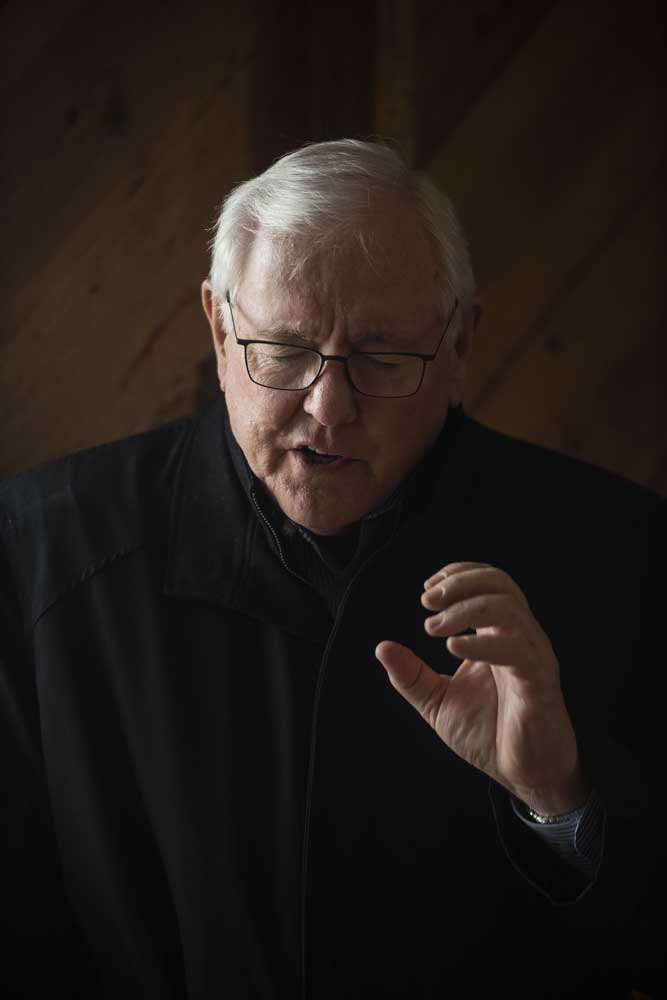Former Dallas detective reveals moments with Lee Harvey Oswald
Published 9:29 pm Saturday, November 22, 2014

- Elmer Boyd, a Navy veteran who served as a gunner's mate in the North Atlantic and Caribbean during World War II, visits the "Lone Sailor" statue at the Navy Memorial in Washington DC during a visit to Washington as member of the Brooksire's Heroes Flight on Oct. 27-30, 2014. Boyd is a former Dallas homicide detective who played a role in investigating the assassination of John F. Kennedy by Lee Harvey Oswald.
Elmer Boyd spent almost two days joined at the hip with one of the most infamous assassins in U.S. history — Lee Harvey Oswald.
Boyd, 87, of Blooming Grove, was assigned as Oswald’s escort shortly after the former Marine’s arrest for shooting Dallas Police patrolman J.D. Tippit on Friday afternoon, Nov. 22, 1963. Boyd walked a handcuffed Oswald to and from numerous interrogations and police lineups, where witnesses to Tippit’s shooting identified Oswald as the triggerman.
That day’s assignment for Boyd and his partner Richard Sims had been to provide security for Kennedy at the Trade Mart luncheon, where the president was scheduled to speak.
Boyd said the tenor among Dallas’ citizenry was icy toward the administration, but local law enforcement officers and Kennedy’s security detail made light of “something happening” during the president’s Dallas visit.
Dallas Police Capt. J.W. Fritz was among those who were concerned, and Boyd said he wrangled over security precautions with Secret Service and FBI agents.
“I don’t believe you’ve been listening to the same people I’ve been listening to in the grocery stores and barbershops,” Boyd recalled Fritz saying to heads of Kennedy’s security. “The feeling is running pretty high against Kennedy right now, and if something should happen it would be the worst thing for Dallas, Texas.”
Minutes before the president was expected to arrive at the luncheon, Boyd received word the president had been in an accident and was being rushed to Parkland Hospital.
Boyd, Sims and Fritz rushed to the hospital, and learned en route that the president had been shot. Upon arrival, they received word to go to the Texas School Book Depository. By the time they arrived, the building was surrounded by armed officers, who swarmed over every floor of the building, Boyd said.
While surveying the suspected crime scene on the sixth floor of the depository, word circulated that Dallas Police Officer J.D. Tippit had been shot and the suspect was in custody.
Soon, officers located three spent rifle shells and a rifle on the sixth floor.
Because Oswald was the only depository employee unaccounted for, Fritz gave his Irving address to Boyd and Sims. But before leaving for Irving, the officers learned Oswald already was in custody and was the suspect in Tippit’s shooting.
Oswald had been captured in a theater less than two hours after President John F. Kennedy was shot.
Oswald denied shooting Tippit or President Kennedy.
But Boyd searched Oswald and in his pocket found five .38-caliber pistol bullets, the caliber used to kill Tippit.
OSWALD IN CUSTODY
While in custody Oswald talked about anything but the shootings, Boyd said. He talked about his trip to Russia and meeting his wife there. He talked about passing out pro-Cuba literature in New Orleans.
But he would clam up when asked about his involvement in the murders.
“Oswald wasn’t a dummy,” Boyd said. “He would try to interrogate you if you weren’t watching him.”
Boyd said Oswald became emotional only once while in custody, slamming his handcuffed hands down on a table inside the interrogation room after yelling at an FBI agent who had made multiple visits to his home to question his wife.
The routine for Boyd revolved around moving Oswald to and from four lineups, several interrogations and a “press showing” Saturday around noon.
Boyd is captured in several iconic photographs at Oswald’s side, leading him in handcuffs through the hallways of police headquarters.
Boyd said he sat in on 75 to 80 percent of the interrogations and spent long hours as Oswald’s primary handler.
OSWALD’S LAST HOURS
At about 3 a.m. on Sunday morning, Boyd and his partner Richard Sims walked Oswald back to his holding cell. Sims noted it would be the “easiest thing to take him to jail right now,” Boyd said. But media were promised a perp-walk the next morning.
“Everybody knew when he would be moved,” Boyd said.
Boyd and his partners were not assigned to Oswald’s move from police headquarters to county jail Sunday at about 11 a.m. During that transfer, nightclub owner Jack Ruby fatally shot Oswald, an incident broadcast live on television.
Boyd speculated Ruby might not have gone through with Oswald’s murder had he and his partner been at Oswald’s side. Sims knew Ruby very well from years working in Dallas’ vice unit, Boyd said.
Ruby called Sims Saturday night to see if he could bring about 30 sandwiches he’d made for officers at the police station, Boyd said.
“Ruby might have lost his nerve if he’d have seen us walking Oswald,” Boyd said. “But who knows.”
NO CONSPIRACY
Despite throngs of conspiracy theories surrounding Kennedy’s death, Boyd believes Oswald alone assassinated Kennedy and then killed Tippit while attempting an escape.
“I’ve never had any doubts he did it and was a loner,” he said. “But I don’t try to change anybody else’s mind.”
Each year around the assassination’s anniversary, Boyd receives increased inquiries from reporters looking to interview him about his role in history. Boyd said he didn’t agree to a media interview for 40 years after the event.
Boyd and Jim Leavelle, who was famously photographed handcuffed to Oswald as Ruby opened fire in the police headquarters basement, are the last remaining of about 20 Dallas officers who participated in the investigation of Kennedy’s death.
Boyd joined the Dallas Police Department in 1952. He worked patrol until 1957, when he was moved to homicide. He lives in Blooming Grove with Yvonne, his wife of 64 years. They have three daughters, five grandchildren and 12 great grandchildren.
“Not a week goes by that I don’t receive something, a phone call or photos, regarding those hours and days after the president was shot,” Boyd said.







